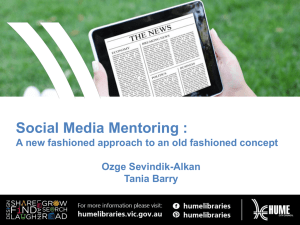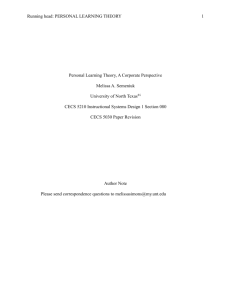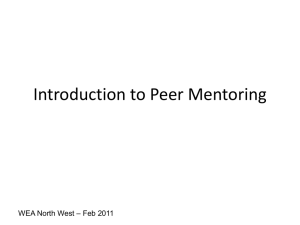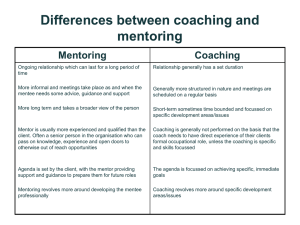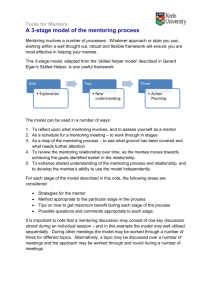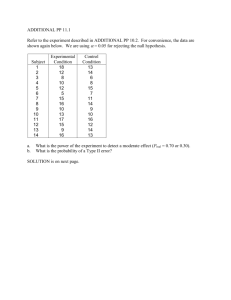The 5Cs Model of Mentoring
advertisement
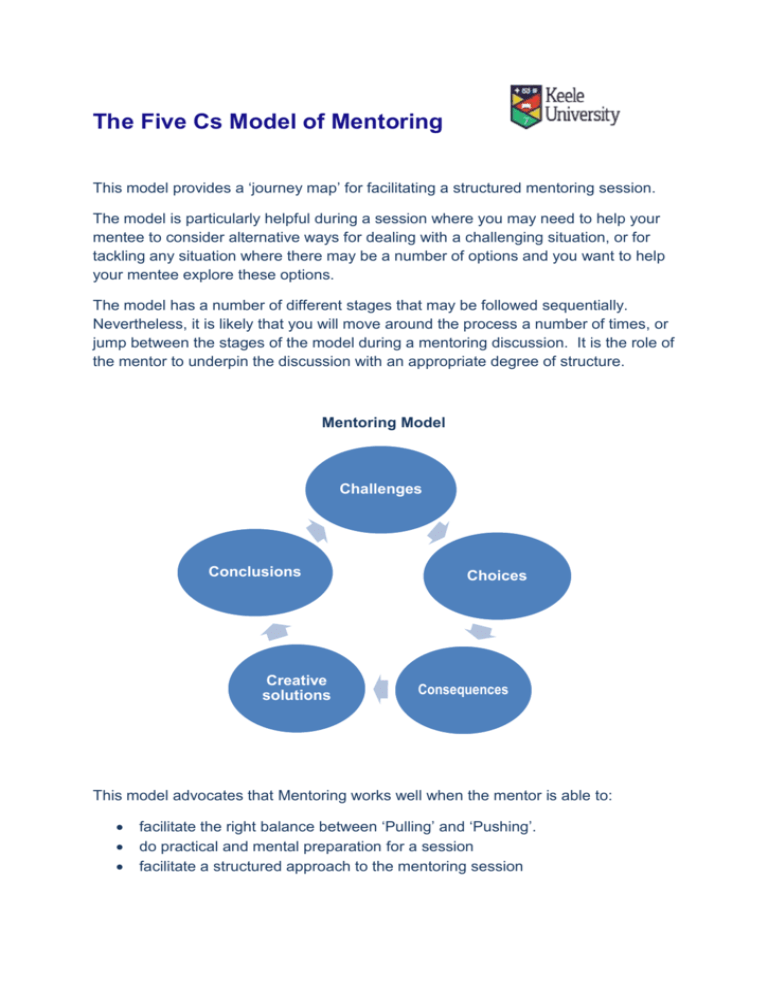
The Five Cs Model of Mentoring This model provides a ‘journey map’ for facilitating a structured mentoring session. The model is particularly helpful during a session where you may need to help your mentee to consider alternative ways for dealing with a challenging situation, or for tackling any situation where there may be a number of options and you want to help your mentee explore these options. The model has a number of different stages that may be followed sequentially. Nevertheless, it is likely that you will move around the process a number of times, or jump between the stages of the model during a mentoring discussion. It is the role of the mentor to underpin the discussion with an appropriate degree of structure. Mentoring Model Challenges Conclusions Creative solutions Choices Consequences This model advocates that Mentoring works well when the mentor is able to: facilitate the right balance between ‘Pulling’ and ‘Pushing’. do practical and mental preparation for a session facilitate a structured approach to the mentoring session Mentors should start ‘where the mentee is at’, and then they should nurture learning by two main methods: Pulling and Pushing. Pulling requires the mentor to: Offer a sanctuary – a reflective space outside of the normal working, study or research environment Offer a safe place where the person feels able to share their agenda, interests and goals Offer support by listening, asking the right questions and drawing out the mentee’s own responses to their problems and issues. Pushing requires the mentor to: Offer stimulation to help the mentee reflect in different or deeper ways, and to consider alternative perspectives Offer challenge as well as creative ideas, knowledge, success stories, models, tools, leading edge thinking and wisdom Offer ‘take away’ value that the mentee finds relevant and of value. Good mentors balance these two approaches, but, when in doubt, they Pull rather than Push to ensure that the mentee stays in control and can fulfil their agenda. Working with this model The structured approach has a number of possible questions appropriate to each stage of the 5cs model of mentoring. These are set out within each stage of the model below. A number of pre-meeting questions are also offered. Contacting the mentee in advance of a session to ask for some general information about what the mentee might like to discuss at the meeting allows the mentors to prepare in advance of a mentoring session, and helps to ensure that the mentee has thought through what they would like to gain from the session. Many of the questions cover similar ground, so choose those that fit your style or are most appropriate to the individual context. Some questions cover both personal and professional life. As a mentor it is important that you use questions that you are comfortable with and that fit the kind of mentoring session you are engaged in. Preparing for a mentoring session Some questions you might like to ask your mentee before your meeting What issues would you like to discuss in the session? What are the key challenges you are currently facing? What outcomes would you like to achieve? What would make it a successful session? Please can you e mail the key challenges you would like to discuss during our (next) mentoring session? Challenges Some possible questions during the challenges stage: Opening questions: What are your goals for the session? What issues would you like to discuss? What outcomes would you like to achieve? What for you would make this a successful session? What are the key challenges you are currently facing? What are the key things you need to focus on in the next week / month / semester / year? What are the three key things you can do to give yourself the greatest chance of success? Exploratory questions: Which is the first challenge you would like to explore? Can you give me a picture of what is happening? Can you give me a specific example? What would you like to happen instead? What would be a positive outcome? What are the real results you would like to achieve? Before exploring this challenge more deeply, let’s revisit your own individual contribution to your work. What are your strengths? What do you enjoy doing? What do you do best? What is your picture of ‘perfection’? How do you feel when you are engaged in activity that you do well / find meaningful? If you are looking back in future years, what will you have done for you to consider your work / life to have been successful? Let’s go back and explore the first/next challenge you want to tackle. Choices Some possible questions during the choices stage: Looking at the first challenge: What do you see as the possible options you have for tackling the challenge? What is Option A? o What are the steps you would need to take if you followed this option? What do you see as Option B? o What are the steps you would need to take if you followed this option? Every option has both pluses and minuses and later we will be considering these consequences. For the moment, however, let’s just explore what you see as all your possible options for tackling this challenge. What do you see as Option C? Option D? Option E? Can you think of any other options? What else have you tried before? What were the consequences? Do you see any of these as possible options? Is there anything we haven’t thought about so far? If so, is there anything else you would like to add to the list of possibilities? Maintaining the status quo and doing nothing is sometimes an option. Is this a possibility in your case? If so, what do you think would happen if you did nothing? Does this seem enough options? If so, let’s go on to consider the consequences. We can always come back later and add to the options. Consequences Some possible questions during the consequences stage: What do you see as the pluses and minuses involved in pursuing Option A? Are there any positives? Are there any benefits that aren’t immediately obvious? Let’s move on and consider the downside. What do you see as the minuses of taking Option A? Describe all of the possible negatives. What do you see as the possible pluses and minuses of pursuing Option B? Option C? Option D? Option E? Let’s build a complete picture of the consequences involved in pursuing the different options for tackling this challenge. We will soon be moving on to exploring some potential creative solutions. But first I would like you to check your gut feeling for each of the possibilities you have described. Take a look at the different routes you can take: How attractive do you find each of these options? Let’s rate the attractiveness of each of the options. Do this on a scale of 0 to 10. Take a minute to rate each of the possible solutions – and to consider why you have given them these ratings. Creative Solutions Some possible questions during the creative solutions stage: Let’s take a helicopter view of your options and see if there are any possible creative solutions: What are the real results you want to achieve? How can you do your best to achieve these outcomes? When do you want to achieve these outcomes? Looking at the options you have created is it possible to take the best parts from each option and create a new road? How would this look? Let’s look back for a moment and learn from your successful history. Have you ever been in a similar situation in the past and managed it successfully? What did you do that led to the successful outcome? What are your successful patterns in life / study / research / work How can you follow these paths again in the future? Let’s explore what we can learn from best practice and positive models. Are there any other people, teams, institutions that have successfully managed this kind of challenge? What did they do to manage it successfully? How can you follow these principles in your own way? Let’s imagine you had a blank sheet of paper. What would you do if: You could start all over again tomorrow? You could do whatever you needed to fulfil your picture of the perfect outcome? How can you follow these principles in this situation? Let’s focus on your best contribution: What are your strengths? How can you use these to tackle this challenge? What help do you need from other people with other knowledge / expertise / networks Let’s focus on your key ‘sponsors’. Who are your key sponsors? How can you satisfy these people? What support do you need from your sponsors? How can you make a clear contract with them to ensure your satisfy your sponsors? Let’s conclude by exploring any other possibilities. Looking at the challenge, is there anything else you can do? Are there any ‘far out’ possibilities? Or possible imaginative solutions? Let’s settle on the route you want to pursue. Looking at what we have discussed, what is your chosen option? What must you do to make this happen? Finally, What is your back-up plan? What do you want to do if your first option does not succeed? What are your second and third options? Conclusions Some possible questions during the conclusions stage: Time to conclude what has emerged from the discussion and how you want to tackle the chosen challenge. Let’s explore the option you have chosen: What will be the pluses? What will be the minuses? How can you build on the pluses and minimise the minuses? Bearing these consequences in mind, are you prepared to go ahead? Let’s move on to your Action Plan. What steps must you take to reach your goals / outcomes? How can you take these steps? When do you want to begin? What can you do to get some early successes? Make a list of the tasks and a timetable. Let’s conclude with a reality check. On a scale of 0 to 10: How much do you rate your desire to pursue this option? How much do you rate the possibility of it being successful in reaching your goals? What is the next challenge you would like to discuss? Source: Adapted from: Pegg, M. The Art of Mentoring, Management Books 2000 Ltd., 2003 ISBN 1-85252-272-0
